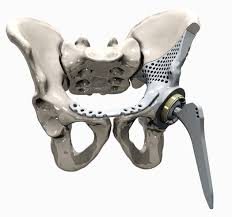 Additive Manufacturing Status in the Orthopedics Industry (Orthopedic Design & Technology)
Additive Manufacturing Status in the Orthopedics Industry (Orthopedic Design & Technology)
see all 3D Printing stories
Implants expo organizer offers a brief synopsis of the sector.
Zimmer, one of the major orthopedic companies, penetrated this market 15 years ago with a proprietary technology acquired from Implex, thereby opening the trabecular structure market with an investment of several hundred million U.S. dollars.
In 1997, Zimmer used clinically trabecular metal based on the tantalum vapor deposit process for the hip cup. In 2007, Adler Ortho (Italy) used its first trabecular titanium cup—Fixa Ti-Por. Between 2008-2011, 109 Lima Delta TT cups were implanted in 98 patients. In 2009, Medtronic launched the Fuse Lumbar PLIF Cage made via additive manufacturing. In 2011, Exactech was the first U.S. company to offer FDA-cleared implants made via additive manufacturing technology; its Intergrip porous metal acetabular represented the first implantation.
The main benefit of additive manufacturing for orthopedics is the bone ingrowth capabilities. It also enables the manufacture of complex metal parts simultaneously for different sizes, shapes, and design. In the industrial field (mainly aeronautics), the additive manufacturing users are looking for weight reduction or advanced cooling.
Additive manufacturing is now a mature technology in orthopedics as it has been used for more than 15 years in the industry. With additive manufacturing, Italy offers the most advanced market; following Zimmer, the historical player, challengers like Lima Corporate and Adler Ortho have invested heavily in this technology. The main trabecular products are hip cups (several thousand are sold in Italy each year) followed by other products such as shoulder implants, knee tibial plates, and mini-hip stems.
Spinal cages manufactured via additive manufacturing represents one of the most dynamic orthopedic segments. For example, in Europe, PEEK cages are expected to lose market share (-4.5 percent CAGR by 2018) and titanium cages are anticipated to see a decrease of 2 percent in the five main countries. Meanwhile, additive manufacturing and trabecular cages are expected to increase by 19 percent and reach 61,000 units in 2018.
Industry Invests in Additive Manufacturing
In 2014, almost 25 orthopedic products that were manufactured via additive manufacturing received 510(k) clearance in the U.S. More specifically, Stryker, another major orthopedic company, has received 510(k) clearance for several orthopedic implants manufactured with additive manufacturing technologies. Stryker’s CEO, Kevin Lobo, announced that an additive manufacturing facility was being built in 2016, which partially accounted for a high level of planned capital expenditure (approximately $400 to $450 million). During the company’s Q4 2015 earnings call, the company’s CEO also said additive manufacturing knee implants bolstered sales of the company’s orthopedic devices. An additive manufacturing spinal implant is scheduled for launch this year, and the company has a “huge line-up of other divisions with ideas and prototypes to get into 3D-printed titanium products.”
In early 2016, Smith & Nephew announced the launch of the Redapt Revision acetabular fully porous cup manufacturered using additive manufacturing technology. The Redapt gained FDA clearance in November 2015.
Conclusion
In 2015, if the orthopedic industry used 1,500 to 2,000 tons of titanium, additive manufacturing required less than 50 tons (<3 percent of the total). This year, Lima Corporate will need almost 2 tons of titanium for additive manufacturing and Adler Ortho will require 0.7 tons.
From 2014-2021, the market growth for additive manufacturing in metal will be between 18 and 30 percent, according to several industry forecasts. Orthopedic applications will be one of most dynamic segments.
Since 1990, Ali Madani, the managing partner at Avicenne Consulting, has been working on strategic and marketing studies in the medical sector. He has advised major players in this industry (Medtronic, Stryker, Zimmer, Depuy, etc.) on strategy development and implementation, technical and economic appraisals, and mergers and acquisitions. Madani has also advised multiple private equities firms on acquisitions and build-up (Deals: Tecomet, Lima Corporate, Amplitude Ortho, Marle, etc.). He has also advised medium- and small-sized companies for market research and strategic partnerships in the U.S., Europe, and BRICs. In 2005, Madani founded the annual medical industry conference and exhibition, Implants, over which he has presided ever since.